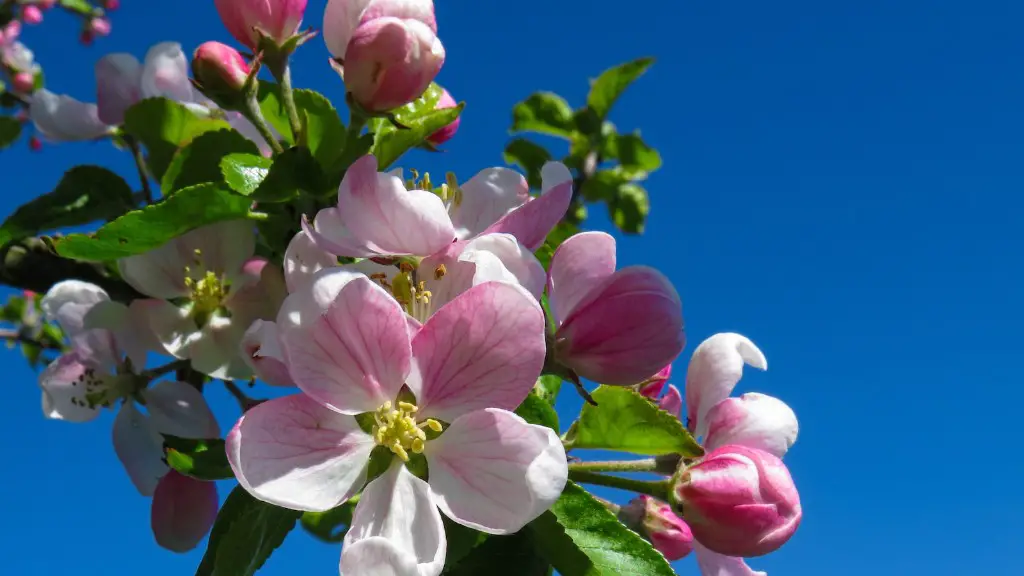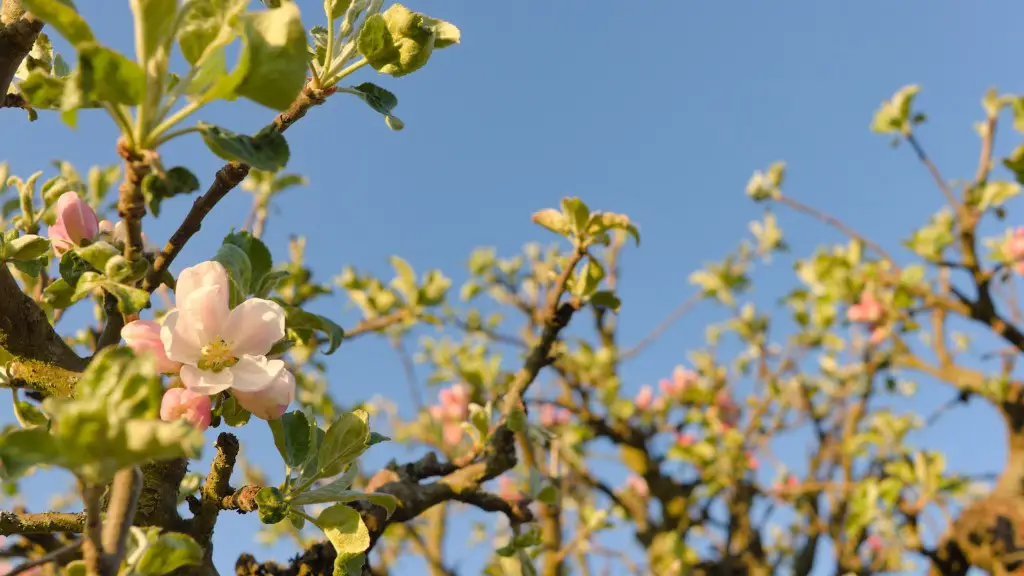Trimming an apple tree in the spring is a great way to promote a healthy and fruitful tree. Pruning during the dormant season lets a tree concentrate its energy on the production of fruit and it can make a significant contribution to the overall yield. Pruning can be a tricky process, so it is important to understand how to properly trim an apple tree when the season begins.
When it comes to apple trees, regular pruning is essential. All dead, broken and crossing branches should be removed while still dormant, as this encourages the tree to focus its energy toward healthy fruit production. In early spring or late winter, look for any dead or damaged branches and start pruning first. Then, cut back any branches that are crossed over, or growing out too far from the trunk of the tree. Controlling the shape of the tree will help ensure proper airflow and sunlight for the tree. Once the dead and crossing branches are removed, your tree is ready for delivery pruning.
Delivery pruning involves removing any branches that are less than 18 inches from the base of the tree. These branches will not contribute to the production of quality fruit and can often become entangled in other branches. It’s best to prune these off before any new growth begins. Pruning at this stage will help to ensure proper airflow and light for the new fruit as well as helping to promote future growth.
Pruning during the late winter or early spring can also be beneficial in controlling the size of the tree. It is important to prune the branches that are degenerating, thick and large, as these can often become too heavy towards the end of the season and can cause damage to the tree or the fruit. Prune away any branches that are thicker than the size of a thumb. You should also check for any forks in the branches, as these can create weak points in the tree structure.
Finally, apple trees should be pruned to allow light and air through the canopy. This will encourage healthy foliage and fruit growth. When cutting, avoid leaving any large stubs. Prune up from the branch collar and make sure you don’t leave any open wounds. Proper pruning will help to ensure a healthy and fruitful tree for many years.
Shaping Your Apple Tree with Pruning
Once your apple tree is trimmed, shaping it with pruning can maximize its production of healthy fruit and create an aesthetically pleasing look. Pruning your apple tree early in the season to promote shape and structure will increase the productivity of the tree and ultimately yield better-quality apples. When shaping the tree, focus on the canopy, removing branches that are unnecessary or hindering the growth of healthy fruit and foliage.
Pay attention to the size and shape of the apple tree. Avoid pruning heavily in one area, as this could impede the balance of the tree. Use your pruning shears to selectively take off large branches that are growing immensely or severely crowding the tree’s canopy. By deselecting large branches, the tree will appear more open and allow for better airflow and light supply to the tree.
After cutting off the large branches, focus on the smaller ones that are making the apple tree look dense. If a branch is not contributing to the growth and production of the apples, it should be taken off. Get your pruning shears and start trimming the branches lightly to create an even size and shape to the tree. Make sure that you are going in between the branches. If done correctly, this will allow the branches to keep a neat and uniform look.
Pruning an apple tree doesn’t have to be a daunting task. Taking some time to assess the tree before cutting off any branches can be incredibly beneficial. Also, make sure to avoid pruning away more than 25 percent of the main branches of the tree. Doing so can significantly impact its growth and production. With these tips in mind, you can easily shape an apple tree for optimal yield with minimal effort.
The Benefits of Trimming an Apple Tree in Spring
Trimming an apple tree in the springtime provides a host of benefits for the health and production of the tree. Pruning during the dormant season supports new growth in the upcoming season and encourages healthy and vibrant foliage. If done correctly, it can also help increase the production of apples and create an aesthetically pleasing look.
Firstly, pruning an apple tree in spring prevents disease. Removing branches that are diseased or overgrown can help prevent the spread to the healthy parts of the tree. Doing so will also reduce the risk of diseases that can weaken or damage the tree over time alongside increasing the harvesting of apples.
Trimming an apple tree during the spring season also ensures air circulation throughout the tree. This increases the potential yield of quality apples in the harvest, as air circulation helps to ensure the apples mature properly. Additionally, optimal air circulation helps to keep the tree healthy due to the balanced environment it provides.
Furthermore, trimming and pruning at the beginning of the season prevents overcrowding and improves the tree’s structure. When a tree is overcrowded, some branches may not get the requisite sunlight and nutrients that they need to stay healthy. By thinning the branches, light can penetrate each branch, resulting in a healthier canopy.
Finally, an apple tree’s shape and structure can be improved with regular pruning. Removing unnecessary branches lets the tree focus its energy on the growth of new branches and the production of quality fruit. Proper pruning can create an aesthetically pleasing shape and structure that is both attractive and productive.
The Right Tools and Safety Tips for Pruning an Apple Tree
Pruning an apple tree is a time-consuming but worthwhile process if done correctly. When trimming an apple tree, it is important to have the right tools and take the necessary safety precautions to ensure the best and most efficient results.
Firstly, choose the right tools for pruning. Loppers, hedge shears, and hand saws are the most common tools for pruning an apple tree. Hand saws are best for getting rid of larger branches and hedge shears are perfect for trimming smaller ones. Loppers are great for cutting off in-between sized branches. Secondly, ensure that your tools are clean and sharp. Having clean and sharp tools prevents any potential diseases from spreading throughout the tree.
In addition to having the right tools, safety should be a priority when pruning an apple tree. Always wear sturdy gloves and work clothes to protect you from sharp branches and thorns. Furthermore, always work with a partner—this can help prevent any accidents if a branch unexpectedly breaks or falls. Finally, always start pruning at the top of the tree and work your way down. Pruning at the top first prevents issues when pruning lower branches and ensures the best results.
Maintaining an Apple Tree With Regular Pruning
Regularly trimming and pruning an apple tree can greatly reduce its workload and help it stay healthy and productive. It is important to prune your tree every year when the season starts to ensure its longevity and productivity.
Pruning young apple trees is essential for proper growth. Apple trees should be pruned when they are 3-4 years old to ensure healthy fruit production and can be pruned for the first time in late winter or early spring.
When pruning an apple tree, it is important to make sure that you remove any dead or crossing branches first. Take out any branches that are less than 18 inches from the base of the tree and shape the canopy to create an open, airy atmosphere. Finally, don’t trim away more than 25 percent of the main branches of the tree, as this could significantly impede the tree’s growth.
It is also important to note that apple trees should be pruned differently in different climates. In colder climates, it can be beneficial to prune in the late winter, when there is still some dormancy. Pruning early in the season can also help avoid winter injury due to the harsher weather conditions. In warmer climates, pruning should be done in the late winter or early spring, as this is when the tree is actively growing.
Finally, it is important to regularly inspect your apple tree to ensure it is healthy and producing quality fruit. Regular pruning will help the tree stay healthy and productive for many years. With the right care and maintenance, an apple tree can provide delicious fruit for years to come.





